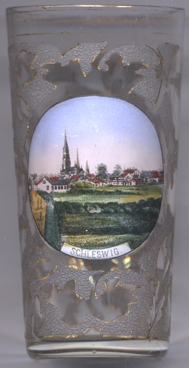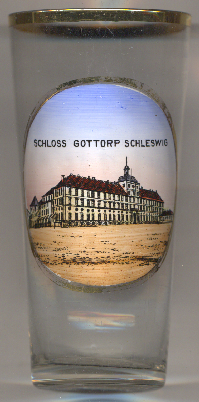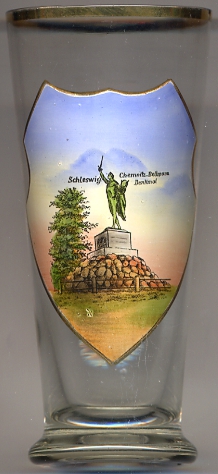

|
| DEUTSCHLAND | GERMANY |
| Bundesland: Schleswig-Holstein | |
| Kreis: Schleswig-Flensburg |
Schleswig is situated at the western end of the Schlei, a fjord of the Baltic Sea which separates the two peninsulas Angeln to the north and Schwansen to the south, about halfway between Schleswig-Holstein's capital, Kiel, and Flensburg at the Danish border. Schleswig is the capital of the district Schleswig-Flensburg. The municipality of Schleswig has a population of about 23,700 (2012).
 The Viking settlement of Hedeby, located south of the modern town, was first mentioned in 804. It was a powerful settlement in the Baltic region, dominating the area for more
than 200 years. In 1050, following several destructions, the population was moved to the opposite shore of the Schlei, becoming the city of Schleswig. In 1066 Hedeby was finally
destroyed, and Schleswig remained as a part of the Danish kingdom. In 1544 Gottorf Castle became the residence of the local rulers. The dukes of Gottorf were vassals of the
Danish kings and ruled over much of present day Schleswig-Holstein. In 1721, when the Great Northern War ended, the dukes of Gottorf lost their power and their land became
Danish crown land. After the Second Schleswig War (1864), Schleswig was annexed by the Kingdom of Prussia.
The Viking settlement of Hedeby, located south of the modern town, was first mentioned in 804. It was a powerful settlement in the Baltic region, dominating the area for more
than 200 years. In 1050, following several destructions, the population was moved to the opposite shore of the Schlei, becoming the city of Schleswig. In 1066 Hedeby was finally
destroyed, and Schleswig remained as a part of the Danish kingdom. In 1544 Gottorf Castle became the residence of the local rulers. The dukes of Gottorf were vassals of the
Danish kings and ruled over much of present day Schleswig-Holstein. In 1721, when the Great Northern War ended, the dukes of Gottorf lost their power and their land became
Danish crown land. After the Second Schleswig War (1864), Schleswig was annexed by the Kingdom of Prussia.
The  cathedral of St. Peter [left, no. 4413: background left]
is the main church of the city of Schleswig and was the cathedral of the Catholic bishop of Schleswig until the diocese was dissolved in 1624. It is now
a church of the North Elbian Evangelical Lutheran Church, the seat of the Lutheran Bishop of Schleswig and Holstein. The first cathedral was built when
the diocese was established in 947 AD. A Romanesque basilica was built between 1134 and ca. 1200. One of the naves of this basilica still can
be seen today. After the collapse of two towers and some parts of the basilica in 1275, the High Gothic hall choir was constructed and completed around
1300. The late Gothic hall church was built from 1200 to 1408 and was finally completed in the 16th century. The external appearance including the
construction of the Gothic revival western tower was accomplished in 1888–1894.
cathedral of St. Peter [left, no. 4413: background left]
is the main church of the city of Schleswig and was the cathedral of the Catholic bishop of Schleswig until the diocese was dissolved in 1624. It is now
a church of the North Elbian Evangelical Lutheran Church, the seat of the Lutheran Bishop of Schleswig and Holstein. The first cathedral was built when
the diocese was established in 947 AD. A Romanesque basilica was built between 1134 and ca. 1200. One of the naves of this basilica still can
be seen today. After the collapse of two towers and some parts of the basilica in 1275, the High Gothic hall choir was constructed and completed around
1300. The late Gothic hall church was built from 1200 to 1408 and was finally completed in the 16th century. The external appearance including the
construction of the Gothic revival western tower was accomplished in 1888–1894.

 Gottorf (Gottorp) castle [near left, no. 4853] has its origins in an estate that was founded
in 1161 as a residence for the bishops of Schleswig. The Danish Duke of Schleswig acquired it through a purchase in 1268, and in 1340 it was
transferred to the Count of Holstein at Rendsburg of the House of Schauenburg. The manor later, through maternal
inheritance, became the possession of King Christian I of Denmark, Norway and Sweden, the first Danish monarch from the House of
Oldenburg, in 1459. Both the island and the structure were extended through the years, and particularly during the
16th century. Christian's son, Frederik I, King of Denmark and Norway, made it his primary residence. When the duchies of Schleswig
and Holstein were partitioned into three parts, Gottorp became the residence of Schleswig-Holstein-Gottorp. The present castle was built in
1697–1703 by the famous Swedish architect Nicodemus Tessin the Younger. After the ducal lineage of Gottorp were forced to move out in 1702,
the palace, now occupied by the Danish, fell into disuse and disrepair. During the 19th century, it was used as barracks by the Danish
and later the Prussians. Since 1947, the palace has been renovated and restored through a series of initiatives. The restoration was considered
complete in 1996. The palace is now owned by a foundation of the State of Schleswig-Holstein and houses the State Art and Cultural History
Museum and the State Archeological Museum.
Gottorf (Gottorp) castle [near left, no. 4853] has its origins in an estate that was founded
in 1161 as a residence for the bishops of Schleswig. The Danish Duke of Schleswig acquired it through a purchase in 1268, and in 1340 it was
transferred to the Count of Holstein at Rendsburg of the House of Schauenburg. The manor later, through maternal
inheritance, became the possession of King Christian I of Denmark, Norway and Sweden, the first Danish monarch from the House of
Oldenburg, in 1459. Both the island and the structure were extended through the years, and particularly during the
16th century. Christian's son, Frederik I, King of Denmark and Norway, made it his primary residence. When the duchies of Schleswig
and Holstein were partitioned into three parts, Gottorp became the residence of Schleswig-Holstein-Gottorp. The present castle was built in
1697–1703 by the famous Swedish architect Nicodemus Tessin the Younger. After the ducal lineage of Gottorp were forced to move out in 1702,
the palace, now occupied by the Danish, fell into disuse and disrepair. During the 19th century, it was used as barracks by the Danish
and later the Prussians. Since 1947, the palace has been renovated and restored through a series of initiatives. The restoration was considered
complete in 1996. The palace is now owned by a foundation of the State of Schleswig-Holstein and houses the State Art and Cultural History
Museum and the State Archeological Museum.

The  Chemnitz-Bellmann monument [near left, no. 2863], located on the Schützenkoppel,
was created in 1894–1896 by the sculptor Paul Peterich. The monument commemorates the authors of the Schleswig-Holstein anthem
Schleswig-Holstein meerumschlungen, Carl Gottlieb Bellmann (music) and Matthäus Friedrich Chemnitz (text). The song was first
performed on 24 July 1844 at the Schleswiger Sängerfest (Schleswig singers' festival) in the place where later the monument was
erected. The next performances took place at the 'Deutsche Volks- und Sängerfest' in Eckernförde and the
'Norddeutsche Sängerfest' in Lübeck (June 1845), followed by the 'Sängerfest in
Würzburg' (August 1845).
Chemnitz-Bellmann monument [near left, no. 2863], located on the Schützenkoppel,
was created in 1894–1896 by the sculptor Paul Peterich. The monument commemorates the authors of the Schleswig-Holstein anthem
Schleswig-Holstein meerumschlungen, Carl Gottlieb Bellmann (music) and Matthäus Friedrich Chemnitz (text). The song was first
performed on 24 July 1844 at the Schleswiger Sängerfest (Schleswig singers' festival) in the place where later the monument was
erected. The next performances took place at the 'Deutsche Volks- und Sängerfest' in Eckernförde and the
'Norddeutsche Sängerfest' in Lübeck (June 1845), followed by the 'Sängerfest in
Würzburg' (August 1845).
[https://de.wikipedia.org/wiki/Schleswig,_Schleswig-Holstein, https://en.wikipedia.org/wiki/Schleswig,_Schleswig-Holstein;
https://en.wikipedia.org/wiki/Schleswig_Cathedral;
https://en.wikipedia.org/wiki/Gottorf_Castle;
https://de.wikisource.org/wiki/Das_Chemnitz-Bellmann-Denkmal_in_Schleswig]
![[scale]](lineal.jpg)